A Cannabis Growing Guide - All that you need to know to get started
- Thread starter Thread starter Kodiak
- Start date Start date
early4surely
Member
Great info man, nuff props although I'm not allowed to boost your karma due to lack of posts. Haven't yet had time to go through the whole thread, will have to circle back.
Bless you for sharing
Bless you for sharing
this great guide truly deserves stickiness.... you managed to cover all bases with well written & balanced instructions, cant say I have ever read a better one.
Thanks :smile:
Here are some more pictures that I had to leave out of the guide due to limited space:
The foot-candle is equal to one lumen per square foot. Lumen is a measure of the perceived power of light. Full, unobstructed sunlight has an intensity of approximately 10,000 foot-candles.
Light Distance Chart HPS

Light Distance Chart MH

The credit goes to CaliGrower who created these charts in the first place. The charts are in imperial units so those more familiar with the metric system will have to use an online converter.
Also, here is a more detalied picture on the male and female flowers, as well as how they develop:
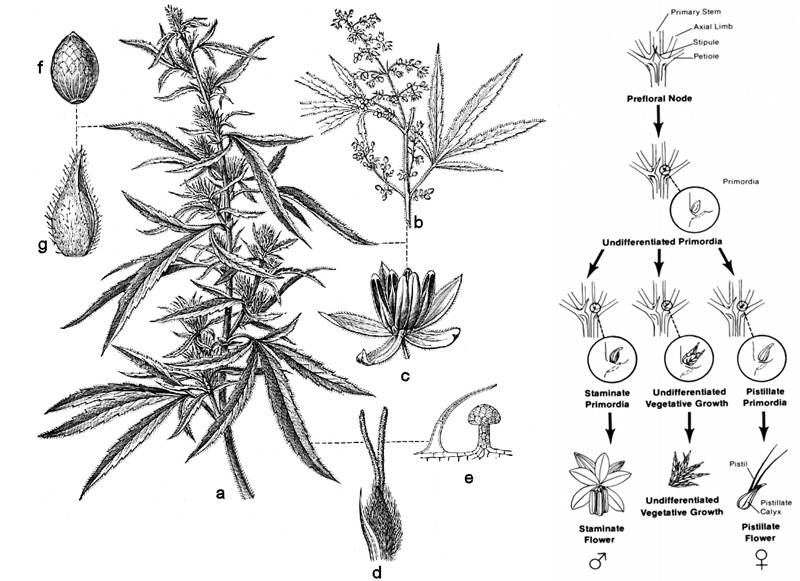
Note here that somtimes there is undifferntiated vegetative growth at the nodes that can be mistaken for male flowers, so when you are sexing you plants, make sure that you wait long enough to be sure before removing any plant from the grow. The undifferentiated and staminate primordia can resemble each other in the early stages of development.
One thing that is good to keep in mind is that if you see more than one distinct "pod" forming at the node, you are most likely looking at a male plant becuase females produce only one elongated calyx at each node. If the preflower starts splitting up into several "pods" you are looking at a male flower.
Here are some more pictures that I had to leave out of the guide due to limited space:
The foot-candle is equal to one lumen per square foot. Lumen is a measure of the perceived power of light. Full, unobstructed sunlight has an intensity of approximately 10,000 foot-candles.
Light Distance Chart HPS
Light Distance Chart MH
The credit goes to CaliGrower who created these charts in the first place. The charts are in imperial units so those more familiar with the metric system will have to use an online converter.
Also, here is a more detalied picture on the male and female flowers, as well as how they develop:
Note here that somtimes there is undifferntiated vegetative growth at the nodes that can be mistaken for male flowers, so when you are sexing you plants, make sure that you wait long enough to be sure before removing any plant from the grow. The undifferentiated and staminate primordia can resemble each other in the early stages of development.
One thing that is good to keep in mind is that if you see more than one distinct "pod" forming at the node, you are most likely looking at a male plant becuase females produce only one elongated calyx at each node. If the preflower starts splitting up into several "pods" you are looking at a male flower.
Graffiti
Member
phenomenal thread kodiak, more like a book lol. This one is getting bookmarked for probably many years of future reference. Shit I might even copy the whole thing and save it directly to my computer. Bravo, truly a great collection of knowledgeable information. Thank you and keep up the good work!


i have a question about your bubbler if u dont mind letting me know, i built one just like it .do u keep the bubbler on all the time or just when the lights are on or is it on a timer for a certain number of minutes on then off for a certain number of minutes?. thanks in advance for any help
Thanks Graffiti and welcome to the thread Danknuggz. All questions are welcomed.
I keep the bubbler on 24/7 because the lights are also on all the time. The light that I use for the clones is just a 11w cfl kitchen light so I cannot put it on a timer even if I wanted. It's mostly a matter of convenince but it also seems like clones do well under 24h light. Just make sure that the plant you are cloning is well fed before you take the cuttings, that way the clones will last longer, which increases their chance of survival. Temperature also plays a key role in successful cloning, keep the water temp slightly higher than room temperature and the clones will do fine. I use a heating mat for that purpose.
I would keep the air flowing all the time even if you give them some darkness because oxygen is the most important component when it comes to the formation of new roots. There really is no reason to turn it off in my opinion. But if you do, I guess that 5 minute intervals four times an hour would be enough for the water to be properly oxygenated, maybe less.
Still, it's easier to just plug it in the bubbler and let it run all the time. Saves you the time to program two timers and gives your plants oxygen in abundance. When I was watching the clones I noticed that the rate at which the roots grow is directly related to the amount of oxygen available.
I have pulled some thirty healthy clones out of this thing and some clones rooted properly in just 6-7 days, with a total survival rate of about 90%. No more KIA's.
I cannot think of a better way to clone.
I keep the bubbler on 24/7 because the lights are also on all the time. The light that I use for the clones is just a 11w cfl kitchen light so I cannot put it on a timer even if I wanted. It's mostly a matter of convenince but it also seems like clones do well under 24h light. Just make sure that the plant you are cloning is well fed before you take the cuttings, that way the clones will last longer, which increases their chance of survival. Temperature also plays a key role in successful cloning, keep the water temp slightly higher than room temperature and the clones will do fine. I use a heating mat for that purpose.
I would keep the air flowing all the time even if you give them some darkness because oxygen is the most important component when it comes to the formation of new roots. There really is no reason to turn it off in my opinion. But if you do, I guess that 5 minute intervals four times an hour would be enough for the water to be properly oxygenated, maybe less.
Still, it's easier to just plug it in the bubbler and let it run all the time. Saves you the time to program two timers and gives your plants oxygen in abundance. When I was watching the clones I noticed that the rate at which the roots grow is directly related to the amount of oxygen available.
I have pulled some thirty healthy clones out of this thing and some clones rooted properly in just 6-7 days, with a total survival rate of about 90%. No more KIA's.
I cannot think of a better way to clone.
B
banjobrain
I agree with everyone else. I too, am a new grower and this is extremely helpful.
Perfect timing with my first grow about to get underway within a few weeks!
Thanks much for the information. You have gone above and beyond the norm in beginning a thread. Well done!
Perfect timing with my first grow about to get underway within a few weeks!
Thanks much for the information. You have gone above and beyond the norm in beginning a thread. Well done!
Kaneh
Member
Kodiak, that's great summary of growing MJ!
Back in the days before internet, I have read hundreds of pages and studied many hours about this subject.
You pretty much covered all I know (and much more) in your first post!
Starting growing is very easy nowadays.
When I started, just to get some books about the subject (or get seeds) we had to flight to Amsterdam!!! LOL.
Gotta love internet!
Back in the days before internet, I have read hundreds of pages and studied many hours about this subject.

You pretty much covered all I know (and much more) in your first post!

Starting growing is very easy nowadays.
When I started, just to get some books about the subject (or get seeds) we had to flight to Amsterdam!!! LOL.
Gotta love internet!
Thanks, I'm glad that you found the guide helpful 
You are right Kaneh, finding information on how to grow is quite easy nowadays, but the good old books on marijuana growing should not be forgotten as they are also a great source of information.
Here are some pictures thatI left out as they were not essential to the guide.
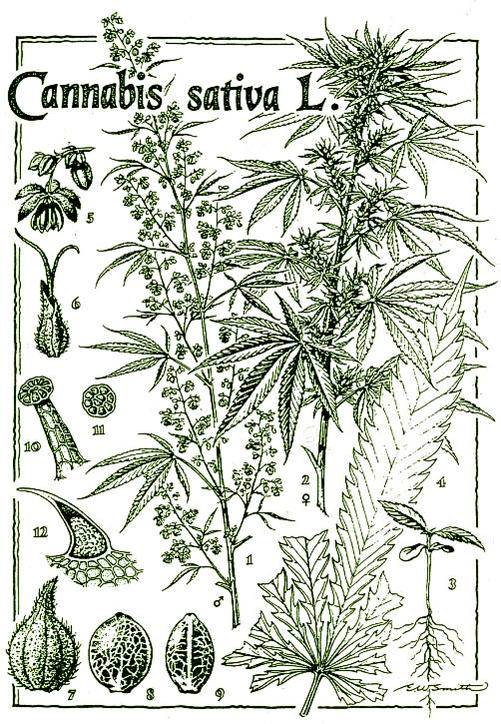

Note the stages of development that the calyx goes through in this picture.
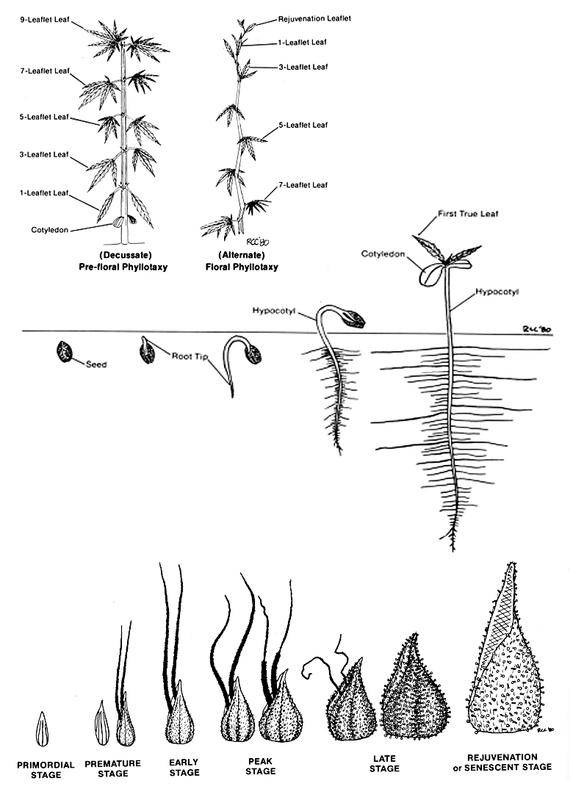
Here is a picture by Phix that shows how the female calyx develops and when to harvest. This is however a rough guideline. The best way to know when to harvest is to look at the trichome development, like I stated in my guide.
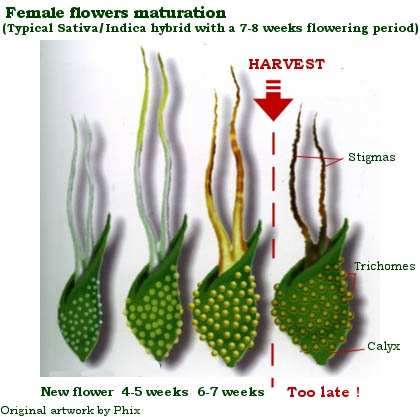
Seed information
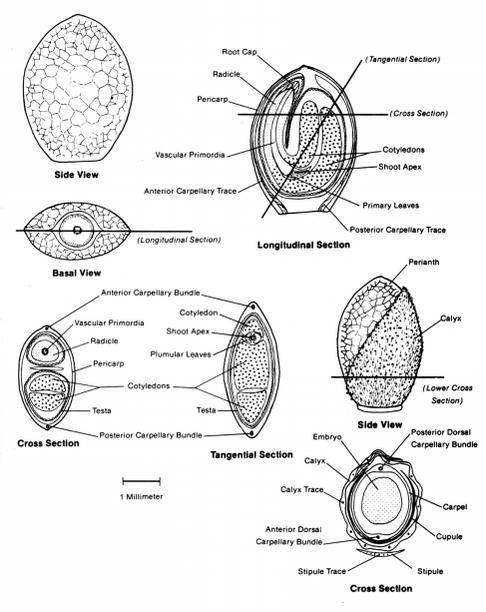
Here are some detailed diagrams on how to LST train your plants, the credit goes to big_buddha for these excellent pics.
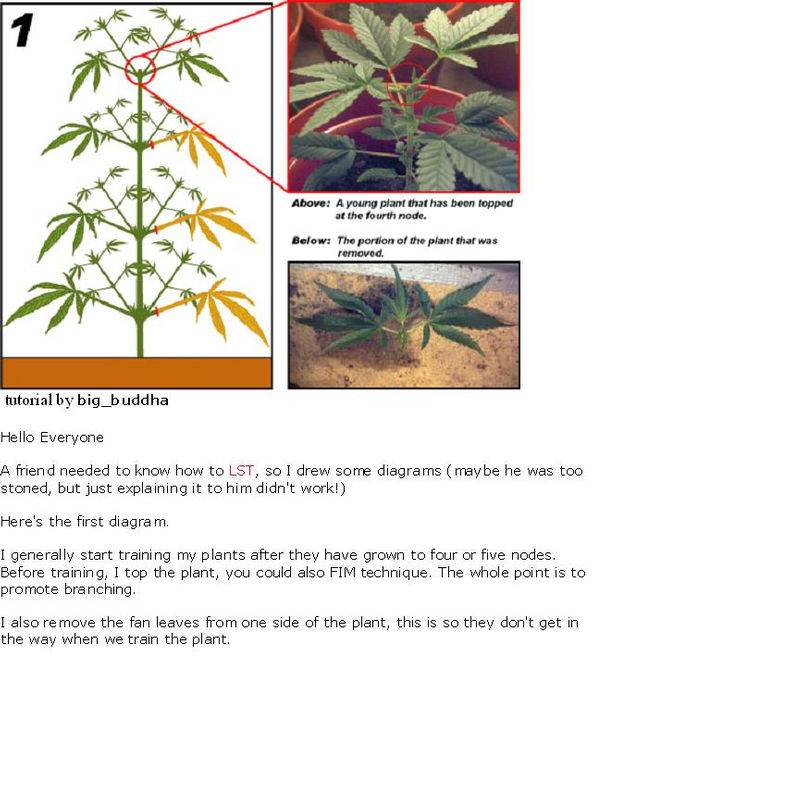
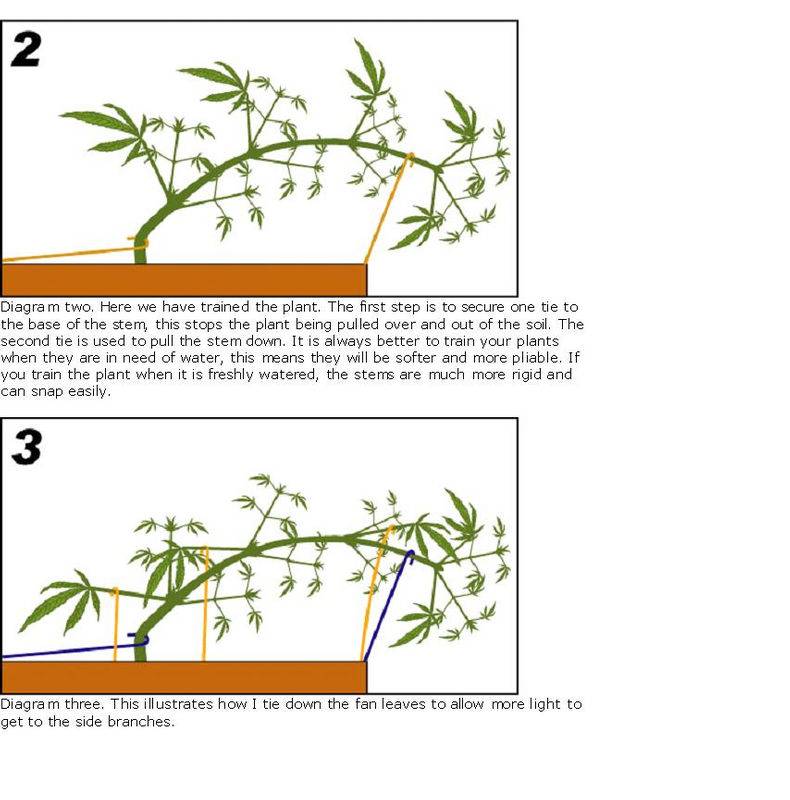
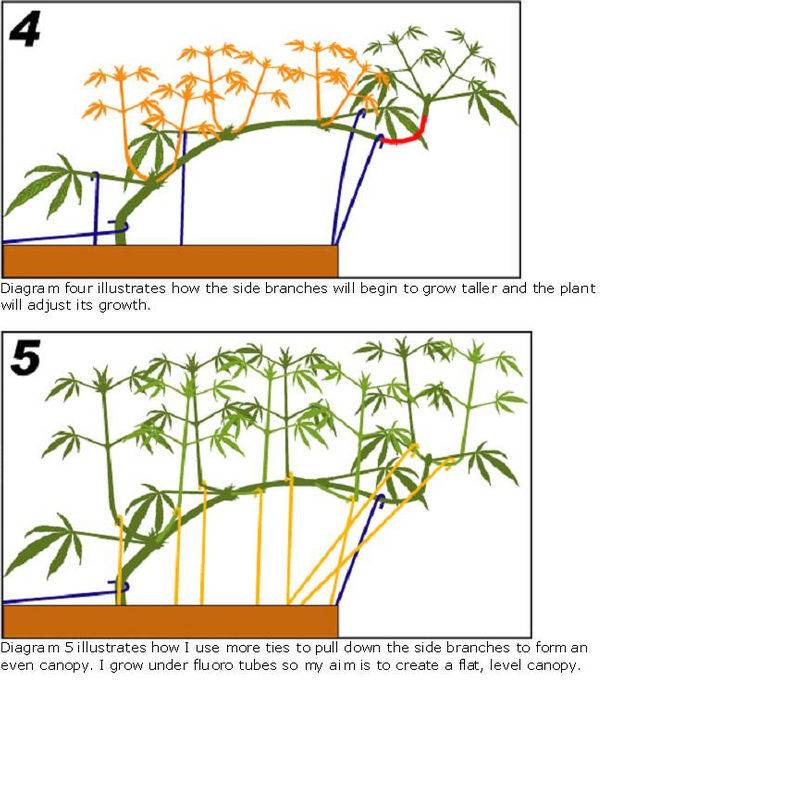
In case you are interested in cannabis grafting, here is a link to the thread that I started on that topic. Grafting is mostly a novelty of the plant world but basically it is possible to create a multi-strain mother plant by grafting scions of different strains onto one plant. Anything is possible when it comes to grafting and arbor-crafting.
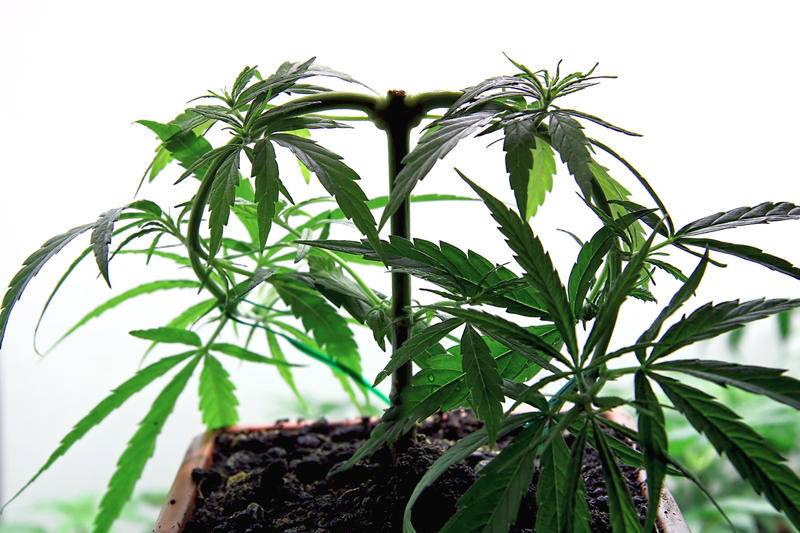
If you have any questions, feel free to ask. I will help you the best I can.
Keep it green :smile:

You are right Kaneh, finding information on how to grow is quite easy nowadays, but the good old books on marijuana growing should not be forgotten as they are also a great source of information.
Here are some pictures thatI left out as they were not essential to the guide.

Note the stages of development that the calyx goes through in this picture.
Here is a picture by Phix that shows how the female calyx develops and when to harvest. This is however a rough guideline. The best way to know when to harvest is to look at the trichome development, like I stated in my guide.
Seed information
Here are some detailed diagrams on how to LST train your plants, the credit goes to big_buddha for these excellent pics.
In case you are interested in cannabis grafting, here is a link to the thread that I started on that topic. Grafting is mostly a novelty of the plant world but basically it is possible to create a multi-strain mother plant by grafting scions of different strains onto one plant. Anything is possible when it comes to grafting and arbor-crafting.
If you have any questions, feel free to ask. I will help you the best I can.
Keep it green :smile:
Kaneh
Member
You are right Kaneh, finding information on how to grow is quite easy with forums like this one, however, a big chunk of the information that I included in this post I learned by reading the good old books on marijuana growing. I have read them so many times that I almost know them by heart.
-Kodiak-
When I said that growing nowadays is easy, I ment that stuff like this thread makes it easy. (not that you got all this info easily)
But the information doesn't come to internet by itself. Somebody has to read the books, do experimenting and learn it the hard way. AND post it to some great forum like IC, which is more work.
People really should be gratefull to all experienced growers and kind folk that has chosed to give that information for free, for anybody to use.
Sure, I see what you mean. It took me many years of research to get to the point where I could write a guide like this one from scratch. All the information was already there, I only had to type it out.
I made notes during every grow and when I put them in order it sort fell into place. I enjoy talking about weed and botany in general as I think that plants are marvelous. They were here long before us and pioneered this planet into the habitable gaia that we have today.
Plants made life on this planet possible and although they are seemingly simple in appearance and function, they are vastly more complex than mammals in many ways. I have always found it funny how plants have managed to fool animals into dispersing their seeds by making fruit that look delicious and taste good, it's all a scam
Actually it's more of a mutualistic relationship but quite clever nonetheless.
The simple fact that plants are autotrophic, meaning that they are capable of producing the energy they need themselves directly from sunlight, is nothing short of magic in a very real way.
Last but not least, they also provide the air that we breathe.
Happy Growing
I made notes during every grow and when I put them in order it sort fell into place. I enjoy talking about weed and botany in general as I think that plants are marvelous. They were here long before us and pioneered this planet into the habitable gaia that we have today.
Plants made life on this planet possible and although they are seemingly simple in appearance and function, they are vastly more complex than mammals in many ways. I have always found it funny how plants have managed to fool animals into dispersing their seeds by making fruit that look delicious and taste good, it's all a scam
Actually it's more of a mutualistic relationship but quite clever nonetheless.
The simple fact that plants are autotrophic, meaning that they are capable of producing the energy they need themselves directly from sunlight, is nothing short of magic in a very real way.
Last but not least, they also provide the air that we breathe.
Happy Growing
Equilibrium
Member
Kodiak, let me say your guide is awesome.
And I think the training pics you have in this page could be very useful in the main post.
And I think the training pics you have in this page could be very useful in the main post.
Thanks Equilibrium. I agree that the training pics by big_buddha are great but the guide already contains the maximum amount of 25 pictures. I would probably have included more in the text as well but it is as long as the forum allows to the last dot.
I do things a bit differently than big_buddha. I usually top the plant first several times over, actually above each new node. Once the plant starts to get bushier I tie down all the branches, which makes the plant fill the pot entirely and eventually grow into a bigger bush. Sometimes I have to tie the branches in a circular fashion along the edge of the pot. During all this time I rearrange the branches by tying them to each other and top and prune them as well, until I get a really wide and bushy plant with lots of nodes from top to bottom.
Different methods of pruning and training could make for a whole new guide in itself as it is an art form that takes some time to learn. I had to learn how to maxmize the crop in a small space so that's were the LST training comes in, combined with topping and pruning. I usually train the plants for several months before flowering them as I am never in a hurry when it comes to growing. The stems are ususally as thick as my thumb even before I flip the switch, so by end end of flowering the plants look more like small trees. The whole process takes a bit longer but I think that it's worth the wait.
Also the "investment planning" I mentioned in the guide is an important part of the training as the plant will distribute it's energy evenly to every part, removing the smaller branches makes the bigger ones stronger and so forth. I eventually remove almost all of the flowering nodes beneath the scrog net but I leave all the leafs and let the plant decide when to drop them. It draws the energy from them and when they turn yellow they drop by themselves.
People who find this thread will probably end up on the page where the LST training pics can be found so it probably evens out in the end.
I could have expanded on every chapter of the guide but keeping the text shorter and untangled seemed like the right choice.
I do things a bit differently than big_buddha. I usually top the plant first several times over, actually above each new node. Once the plant starts to get bushier I tie down all the branches, which makes the plant fill the pot entirely and eventually grow into a bigger bush. Sometimes I have to tie the branches in a circular fashion along the edge of the pot. During all this time I rearrange the branches by tying them to each other and top and prune them as well, until I get a really wide and bushy plant with lots of nodes from top to bottom.
Different methods of pruning and training could make for a whole new guide in itself as it is an art form that takes some time to learn. I had to learn how to maxmize the crop in a small space so that's were the LST training comes in, combined with topping and pruning. I usually train the plants for several months before flowering them as I am never in a hurry when it comes to growing. The stems are ususally as thick as my thumb even before I flip the switch, so by end end of flowering the plants look more like small trees. The whole process takes a bit longer but I think that it's worth the wait.
Also the "investment planning" I mentioned in the guide is an important part of the training as the plant will distribute it's energy evenly to every part, removing the smaller branches makes the bigger ones stronger and so forth. I eventually remove almost all of the flowering nodes beneath the scrog net but I leave all the leafs and let the plant decide when to drop them. It draws the energy from them and when they turn yellow they drop by themselves.
People who find this thread will probably end up on the page where the LST training pics can be found so it probably evens out in the end.
I could have expanded on every chapter of the guide but keeping the text shorter and untangled seemed like the right choice.
Kaneh
Member
I think that plants are marvelous. They were here long before us and pioneered this planet into the habitable gaia that we have today.
Plants made life on this planet possible and although they are seemingly simple in appearance and function, they are vastly more complex than mammals in many ways. I have always found it funny how plants have managed to fool animals into dispersing their seeds by making fruit that look delicious and taste good, it's all a scam
Actually it's more of a mutualistic relationship but quite clever nonetheless.
The simple fact that plants are autotrophic, meaning that they are capable of producing the energy they need themselves directly from sunlight, is nothing short of magic in a very real way.
Last but not least, they also provide the air that we breathe.
Happy Growing :smile:

Dude, Your my hero!



Equilibrium
Member
Thanks Equilibrium. I agree that the training pics by big_buddha are great but the guide already contains the maximum amount of 25 pictures. I would probably have included more in the text as well but it is as long as the forum allows to the last dot.
I do things a bit differently than big_buddha. I usually top the plant first several times over, actually above each new node. Once the plant starts to get bushier I tie down all the branches, which makes the plant fill the pot entirely and eventually grow into a bigger bush. Sometimes I have to tie the branches in a circular fashion along the edge of the pot. During all this time I rearrange the branches by tying them to each other and top and prune them as well, until I get a really wide and bushy plant with lots of nodes from top to bottom.
Different methods of pruning and training could make for a whole new guide in itself as it is an art form that takes some time to learn. I had to learn how to maxmize the crop in a small space so that's were the LST training comes in, combined with topping and pruning. I usually train the plants for several months before flowering them as I am never in a hurry when it comes to growing. The stems are ususally as thick as my thumb even before I flip the switch, so by end end of flowering the plants look more like small trees. The whole process takes a bit longer but I think that it's worth the wait.
Also the "investment planning" I mentioned in the guide is an important part of the training as the plant will distribute it's energy evenly to every part, removing the smaller branches makes the bigger ones stronger and so forth. I eventually remove almost all of the flowering nodes beneath the scrog net but I leave all the leafs and let the plant decide when to drop them. It draws the energy from them and when they turn yellow they drop by themselves.
People who find this thread will probably end up on the page where the LST training pics can be found so it probably evens out in the end.
I could have expanded on every chapter of the guide but keeping the text shorter and untangled seemed like the right choice.
You're more than right about keeping the text short.
Your training technique seems so awesome... You really need to do another thread about pruning and training. I like how you explain things and your philosophy about plants is just great.
Can I bother you a bit later with my plants to see what do you think it's best for them? I'm not sure what to do and I don't want to screw up... If you have some time only.
Last edited:
Thanks 
I could write up another guide where I would focus only on the training & pruning aspect of growing, starting from when the plants are young until they go into flowering. I have a whole bunch of pics that I have taken over the year so maybe I have enough material for a separate guide on that topic. I could include the LST training pics in that thread as they give a very good general picture of the technique.
When it comes to training and pruning I always go by what the plant tells me, every plant gets a slightly different treatment. Even the same plant can take on many different forms when grown from clones.
Sure thing Equilibrium, I'll have a look at your plants later on. They looked good so far in my book, just keep up what you are doing and they will be fine. I don't think that you have to worry too much about screwing up, it is a weed after all so it will make the most out of any situation.
Your setup looks good and the plants also look good at this stage with quite tight internodes You could top them a couple of times soon if you like bushier plants, but they will most likely grow into huge christmas trees with the 1000w blasting them with light so it's a matter of preference. The yellowing of the leafs you mentioned in the infirmary is nothing to worry about. It's really minor and the plants look healthy all and all. Once you have found the nutrient limit for your plants adjust your feeding schedule. Don't feed them too much or they will get nutrient burn or nutrient lock-out problems. Water them and feed them enough but not too much or too often, go by the colour of the leafs. If the leafs have a dark green colour the plant has all the nutrients it can take for the time being. Give them pure ph adjusted water every now and then, that should ensure that they don't get too much. Feed more if the leafs turn a lighter colour.
You could top them a couple of times soon if you like bushier plants, but they will most likely grow into huge christmas trees with the 1000w blasting them with light so it's a matter of preference. The yellowing of the leafs you mentioned in the infirmary is nothing to worry about. It's really minor and the plants look healthy all and all. Once you have found the nutrient limit for your plants adjust your feeding schedule. Don't feed them too much or they will get nutrient burn or nutrient lock-out problems. Water them and feed them enough but not too much or too often, go by the colour of the leafs. If the leafs have a dark green colour the plant has all the nutrients it can take for the time being. Give them pure ph adjusted water every now and then, that should ensure that they don't get too much. Feed more if the leafs turn a lighter colour.
Also, there will always be some yellowing of the leafs in a mature plant as it relocates energy all the time so no need to worry.
It is good to let the pots dry out completely now and then as cannabis plants don't like wet feet, but I understand you have that covered. Some plants are nutrient hungry and others prefer less, this is individual and even plants of the same strain can react differently when it comes to nutes.
Once they are a week or two into flowering it's good to give them a boost of phosphorus (P) as that will also help them trigger full bloom. You still have to keep feeding them nitrogen (N) and potassium (K) in smaller doses as well as trace metals and other micro nutrients that are important for the development of the flowers. Nowadays I know how to feed them just by looking at the plants.
On top of the beneficial micro-organisms that I plant in the soil, I also use growth hormones, root stimulators, nutrient uptake boosters, and soil enhancers throughout the entire grow. That's a lot of different nutes but the sum of all these things keep the plants healthy and I have one less thing to worry about. I'm sure that plant will grow on less (it's weed ) but I believe that if you provide the optimal growing condition for the plants they will have the chance to show their full potential.
) but I believe that if you provide the optimal growing condition for the plants they will have the chance to show their full potential.
I could write up another guide where I would focus only on the training & pruning aspect of growing, starting from when the plants are young until they go into flowering. I have a whole bunch of pics that I have taken over the year so maybe I have enough material for a separate guide on that topic. I could include the LST training pics in that thread as they give a very good general picture of the technique.
When it comes to training and pruning I always go by what the plant tells me, every plant gets a slightly different treatment. Even the same plant can take on many different forms when grown from clones.
Sure thing Equilibrium, I'll have a look at your plants later on. They looked good so far in my book, just keep up what you are doing and they will be fine. I don't think that you have to worry too much about screwing up, it is a weed after all so it will make the most out of any situation.
Your setup looks good and the plants also look good at this stage with quite tight internodes
 You could top them a couple of times soon if you like bushier plants, but they will most likely grow into huge christmas trees with the 1000w blasting them with light so it's a matter of preference. The yellowing of the leafs you mentioned in the infirmary is nothing to worry about. It's really minor and the plants look healthy all and all. Once you have found the nutrient limit for your plants adjust your feeding schedule. Don't feed them too much or they will get nutrient burn or nutrient lock-out problems. Water them and feed them enough but not too much or too often, go by the colour of the leafs. If the leafs have a dark green colour the plant has all the nutrients it can take for the time being. Give them pure ph adjusted water every now and then, that should ensure that they don't get too much. Feed more if the leafs turn a lighter colour.
You could top them a couple of times soon if you like bushier plants, but they will most likely grow into huge christmas trees with the 1000w blasting them with light so it's a matter of preference. The yellowing of the leafs you mentioned in the infirmary is nothing to worry about. It's really minor and the plants look healthy all and all. Once you have found the nutrient limit for your plants adjust your feeding schedule. Don't feed them too much or they will get nutrient burn or nutrient lock-out problems. Water them and feed them enough but not too much or too often, go by the colour of the leafs. If the leafs have a dark green colour the plant has all the nutrients it can take for the time being. Give them pure ph adjusted water every now and then, that should ensure that they don't get too much. Feed more if the leafs turn a lighter colour. Also, there will always be some yellowing of the leafs in a mature plant as it relocates energy all the time so no need to worry.
It is good to let the pots dry out completely now and then as cannabis plants don't like wet feet, but I understand you have that covered. Some plants are nutrient hungry and others prefer less, this is individual and even plants of the same strain can react differently when it comes to nutes.
Once they are a week or two into flowering it's good to give them a boost of phosphorus (P) as that will also help them trigger full bloom. You still have to keep feeding them nitrogen (N) and potassium (K) in smaller doses as well as trace metals and other micro nutrients that are important for the development of the flowers. Nowadays I know how to feed them just by looking at the plants.
On top of the beneficial micro-organisms that I plant in the soil, I also use growth hormones, root stimulators, nutrient uptake boosters, and soil enhancers throughout the entire grow. That's a lot of different nutes but the sum of all these things keep the plants healthy and I have one less thing to worry about. I'm sure that plant will grow on less (it's weed
Equilibrium
Member
Thanks for the anwser Kodiak!
I've taken note of all your precious advices. Growing seems so simple with you.
Precisely I don't really now if I'm going to top them or no... but that's another story and I don't mean to hijack this great thread.
Honestly I hope you will take the time to do a training guide, it would be awesome. Nice job again.
I've taken note of all your precious advices. Growing seems so simple with you.
Precisely I don't really now if I'm going to top them or no... but that's another story and I don't mean to hijack this great thread.
Honestly I hope you will take the time to do a training guide, it would be awesome. Nice job again.


